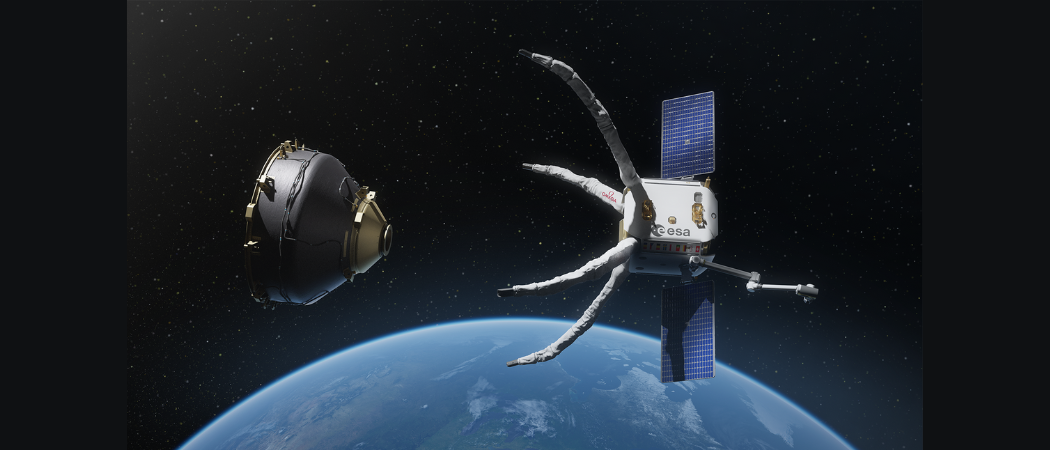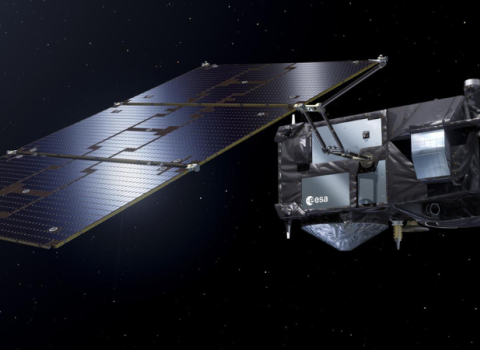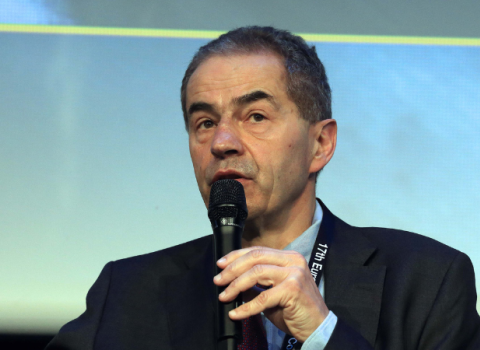Moves to police the afterlife of satellites will open up the market for in-orbit servicing and removal. Meanwhile, the increasing risk of collisions is inspiring development of new space debris monitoring technologies

Photo: ClearSpace
At the beginning of October, the US Federal Communications Commission (FCC) issued its first-ever fine to a satellite operator that had failed to move defunct hardware to a ‘graveyard orbit’ as agreed. The $150,000 makes it clear the FCC has the authority and capability to enforce the rules, creating opportunities for start-ups and others.
Space is becoming increasingly crowded, with large numbers of satellites being launched and many remaining there long after their useful life is over. Collisions and other events in orbit generate debris, which represents a threat to the safe operation of all kinds of space infrastructure. Estimates by the European Space Agency (ESA) suggest there are 36,500 debris objects larger than 10cm in orbit, and around 1 million measuring 1-10cm.
Meanwhile, NASA estimates more than 25,000 objects larger than 10 cm are known to exist. As of January 2022, the amount of material orbiting the earth exceeded 9,000 metric tons.
Of more than 10,000 satellites launched since the first one in 1957, with over half are now out of use.
In recent years, soft incentives to safely decommission satellites have started to turn into hard demands. FCC has led the way, last year reducing the time satellites are authorised to be in low-earth orbit from 25 years to five years, and now issuing its first fine, to Dish Network.
In addition to the $150,000 penalty, the settlement included an admission of liability from Dish and an agreement to adhere to a compliance plan to move its EchoStar-7 satellite 186 miles higher than its geostationary orbit.
“It may not be a very big fine for an operator of this scale, but the fact that there has been an enforcement action like this is a significant change in the way launching states operate,” said Luc Piguet, co-founder and chief executive of ClearSpace, a Swiss start-up specialising in satellite recovery. “It demonstrates that there is a significant shift in the mindset of policy makers and of the licensing agencies, not just in the US but across the world.”
While the size of the fine is relatively modest, it still sends a strong message to the industry. “The motivation for companies is not just the money, and avoiding a $150,000 fine,” said Juan Carlos Dolado, co-founder of Look Up Space, a French start-up developing a space debris monitoring service. “It’s also about their image, and how they are seen by clients, regulators and insurers, for example.”
The regulatory environment is also evolving in Europe. In France, for example, the national space law that came in to force in 2010 was rather vague on the responsibility of satellite operators to avoid collisions. A revision brought forward this year goes further, obliging operators to give priority to safety manoeuvres over station-keeping manoeuvres.
“Each operator now has to work with an actor like us to guarantee space safety,” said Dolado. “So we can see that the regulatory environment is getting more structure, and that will be a catalyst for us. Space safety is no longer an option, it is an obligation if you want to continue to operate.”
Seeing the threat
Look Up Space was founded in 2022 by Dolado, a former head of the space situational awareness office at the French Space Agency CNES, and Michel Friedling, formerly a major general in the French Air and Space Force. In June this year it announced a €14 million seed funding round, split evenly between private investment and public subsidies through France 2030 and French Tech Seed.
At the time, this was the second-largest seed round in Europe for a space tech company, behind German earth observation start-up Constellr, and the largest in France. The company currently has around 20 employees distributed between its Toulouse headquarters and Paris.
The system the company is developing will identify and map the movement of centimetre-scale space debris in low-earth orbit. It will collect the data through a series of radar stations, analysing it to produce alerts that will enable clients to move their satellites out of harm’s way.
With the seed round Look Up Space has advanced development of both elements of the system planned the deployment of the first radar station, near Toulouse in mid-2024. This will enable the company to start commercial operations.
“That will allow us to generate data that is not available anywhere else, and to detect 70% of the objects that we want to detect,” said Dolado, the company’s chief technology officer. Following a second funding round, the plan is to add a further six radar stations, taking advantage of locations in France’s overseas territories to have a global coverage in longitude and latitude.
“Each additional radar will allow us to move incrementally from 70% to 100% coverage, and to improve the reactivity of the system,” Dolado said.
Collison avoidance
Over the past decade, satellite technology has evolved to make manoeuvring to avoid space debris a routine matter. However, without good quality data informing these decisions both time and energy can be wasted.
This was apparent to Dolado in his previous role at CNES, where he oversaw the safety of around 300 satellites. “All of them were able to move to avoid debris, but one of the major problems that we had were false alarms,” he said. “We had low-quality data, and in many cases that meant we were manoeuvring because we were adding margins over the margin of safety, because we didn’t really know the reality in orbit.”
Look Up Space will fill this gap. “We will provide our clients with high-quality, actionable data, allowing them to manoeuvre in an optimal way to avoid a real risk,” Dolado said.
Tow trucks
ClearSpace meanwhile, is tackling the space debris problem at source. The company was set up in 2018 by researchers from the École Polytechnique Fédérale de Lausanne (EPFL) Space Centre to develop technology to capture unresponsive satellites in orbit, either to bring them back into earth atmosphere, where they will disintegrate, or to service them in situ. In 2019 its demonstration recovery mission ClearSpace-1 was picked up by ESA and is currently scheduled for launch in the second half of 2026.
The goal is to capture the upper part of a Vega secondary payload adapter left behind after an ESA satellite launch in 2013. This object is a 2 metre-diameter cone, weighing around 113kg. That is close to the mass of a small satellite, and the simple shape makes it a good case to test both the spacecraft design and the quartet of robotic arms that will be used to grab the object.
The technological challenges involved are considerable. “You have to provide roadside service to a car that is orbiting at 28,000km/h in the void of space, in microgravity, without friction,” said Piguet, ClearSpace CEO. “It is a very slippery object to pick up.”
The final stages of development for the robotic arm technology are taking place in parallel with the design and implementation of the mission itself, so that everything comes together in time for the launch. “The final design of the spacecraft is done, so it’s now about validation, implementation and testing,” Piguet said.
This work is mainly funded by the €86.2 million project budget, provided by ESA and eight participating member states, but the company is also investing its own resources. “We contribute to the programme through equity, partnership and sponsorship,” said Piguet.
In January 2023 ClearSpace announced €26 million series A round. Headquartered in Lausanne, the company has a staff of around 110 and offices around Europe and in the US. .
In addition to the ESA project ClearSpace has been selected by the UK Space Agency to lead Clear, a mission to remove at least two inactive UK satellites from orbit and bring them back to earth atmosphere. This is also working towards a 2026 launch.
Demonstrating the ability to grab an orbiting satellite will be an important step forward for the market. “Once you build the first orbital tow-truck, it will become a normal thing to tow a satellite out of space, or to intervene to do repairs, or make corrections or orbital adjustments,” Piguet said. “There are lot of possibilities from the moment you are able to execute the capture safely.”
Both active recovery missions and in-orbit servicing to extend the life of satellites will help reduce the problems associated with space debris. “We think that in-orbit servicing will become routine in the space industry,” Piguet said. “It may seem expensive at this demonstration stage, but this will evolve with time. Our objective is to bring those costs down.”
Servicing satellites in orbit
Piguet thinks the emerging market for in-orbit servicing will be large enough to accommodate a range of start-ups and established companies. “A whole ecosystem will emerge to operate this kind of servicing,” he said. “Once it is completely established, you can start thinking about the design of satellites and the licensing model very differently.”
A range of companies are already offering space debris intelligence. Some have chosen to focus on observation or on data analytics alone, while others, like Look Up Space, have integrated the two. As the market evolves, Dolado thinks that some kind of natural selection is inevitable.
“My opinion is that the leaders will be those that combine performant observation technology with breakthrough data analytics,” he said. This will involve a strategic choice, since some technologies will perform better for debris in low earth orbits, while others lend themselves to geostationary orbits. “We are convinced that the space safety and security business is in low-earth orbits, not in geostationary orbits,” Dolado said.
However, it is harder to see a market emerging for removing small debris from orbit. Partly that is because of the technical challenges involved: not only are the objects small, but they are widely spread, so collecting them up would involve a lot of time, fuel and cost. Then there is the question of who pays. While it is sometimes possible to trace small space debris back to a specific piece of hardware, most of it is anonymous.
“It’s more difficult to make a business case for smaller objects, but every time we pick up a large one, we essentially pick up lots of small debris, since much of the small debris comes from collisions of large objects,” Piguet said. “Our take is that shielding will make more sense as a solution for smaller debris.”
Elsewhere in the Ecosystem…
- Hyperloop start-ups Hardt and Zeleros, from the Netherlands and Spain respectively, have agreed to collaborate on the further development of their transport systems. Hyperloop systems use autonomous levitating pods to carry passengers or goods at high speed inside low-pressure tubes. The low pressure means that air resistance is substantially reduced, allowing speeds to increase and vastly improving energy efficiency over conventional modes of transport. Europe has a vibrant but fragmented hyperloop ecosystem, and the Hardt-Zeleros partnership could result in technology convergence and ensure interoperability.
- The Centre for Drug Design and Discovery (CD3) in Leuven has raised €70.5 million in its fourth funding round, bringing the total capital managed by the organisation to €154.5 million. Begun in 2006 as a vehicle for supporting medical research spin-outs from KU Leuven university, CD3 now invests in projects and supports start-ups with a range of academic and industry backgrounds. The new capital comes from founding organisations KU Leuven Research & Development and the European Investment Fund, along with the Gemma Frisius Fund.
- The UK government is backing a series of regional innovation hubs for SMEs. These will build on each region’s strengths, such as renewable energy in south west Wales, agriculture and food technology in East Anglia and health technologies in Yorkshire. Each can draw on up to £7.5 million from innovation agency Innovate UK to fund projects led by companies.





 A unique international forum for public research organisations and companies to connect their external engagement with strategic interests around their R&D system.
A unique international forum for public research organisations and companies to connect their external engagement with strategic interests around their R&D system.